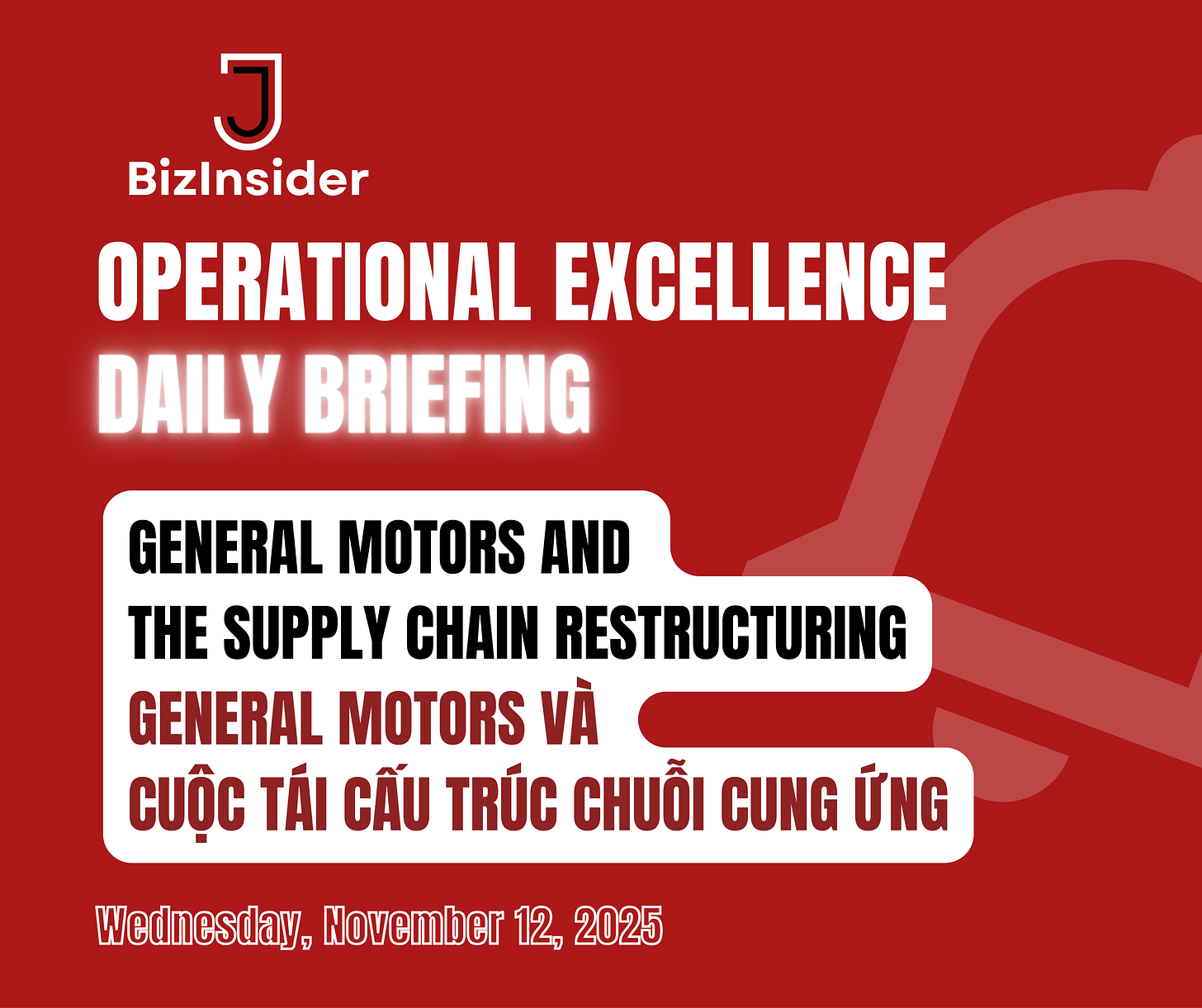Operational Excellence (OPEX) Daily Briefing – Wednesday, November 12, 2025: General Motors and the Supply Chain Restructuring
Điểm Tin Operational Excellence (OPEX) Mỗi Ngày – Thứ Tư, Ngày 12/11/2025: General Motors Và Cuộc Tái Cấu Trúc Chuỗi Cung Ứng
Welcome to my unique weekday article for the paid subscriber-only edition.
Operational Excellence (OPEX) Daily Briefing – issued on weekdays (Monday to Friday).
Điểm tin Operational Excellence (OPEX) hằng ngày (phát hành các ngày thứ Hai đến thứ Sáu).
This is the bilingual post in English and Vietnamese. Vietnamese is below.
Đây là bài viết song ngữ Anh-Việt. Tiếng Việt ở bên dưới.
English
Part 1: Official Statement
On November 12, 2025, General Motors (GM) — one of the world’s largest automobile manufacturers — issued an official notice to thousands of suppliers worldwide, requiring them to gradually eliminate components, materials, and manufacturing processes originating from China in the supply chain. According to the plan, this process is expected to be completed by 2027, marking a major turning point in GM’s operational strategy toward a more autonomous, flexible, and sustainable supply chain.
This information was reported by Reuters on November 12, 2025, and quickly spread across the automotive and manufacturing industries, as it represents not only an economic decision but also one of geopolitical significance. GM became the first American automaker to announce a plan to significantly reduce its dependence on Chinese-sourced components — a move that clearly reflects the global value chain restructuring trend amid rising U.S.–China trade tensions.
According to internal reports cited by Reuters and The Wall Street Journal, GM has asked its suppliers to assess the full origin of their products, including materials, electronic components, and manufacturing processes, to identify any links involving China. The goal is not to “exit” the Chinese market but to diversify the supply chain, expanding collaboration with partners in North America, India, Southeast Asia, and Europe to strengthen resilience against geopolitical and global disruption risks.
A GM representative stated:
“We are moving toward a sustainable, transparent supply chain ecosystem that is less dependent on any single region. This is essential to ensuring GM’s long-term competitiveness in the era of electric vehicles and global manufacturing.”
1. Geopolitical pressure and the need for operational autonomy
For nearly a decade, China has been both a partner and a challenge for global automakers. A wide range of critical components — including batteries, semiconductors, sensors, and electric motors — have supply chains originating in China. However, trade disruptions, U.S. import tariff policies, and recent technological and data restrictions have made dependency risks increasingly difficult to ignore.
For GM, this decision is viewed as a proactive move to ensure production continuity for electric vehicles (EVs) and autonomous vehicles (AVs) — two of the company’s strategic pillars. According to S&P Global Mobility, approximately 20–25% of the value of components in GM’s vehicles currently come directly or indirectly from China. Reducing that percentage in less than three years requires a global operational redesign, including restructuring supply networks, renegotiating contracts, and establishing new quality assurance systems.
2. From “speed” to “resilience”
In the globalization era, supply chain efficiency was often measured by speed and low cost. However, the COVID-19 pandemic and subsequent transportation crises demonstrated that the fastest is not always the most effective.
Today, corporations like GM are redefining efficiency through resilience — the ability to maintain stable operations, recover quickly, and adapt intelligently to change.
According to Deloitte’s 2025 Global Supply Chain Resilience Report, more than 65% of leading manufacturing enterprises are transitioning from “just-in-time” to “just-in-case” models. GM’s decision exemplifies this shift. By distributing risks and building a diversified supply chain, GM is not only safeguarding its production capacity but also reinforcing its strategic position amid political and technological volatility.
3. A signal of strategic transformation in operational management
From an Operational Excellence (OPEX) perspective, GM’s move is not simply about replacing suppliers — it represents a deeper transformation in operational thinking.
Rather than focusing solely on cost efficiency, GM is now prioritizing adaptability and data-driven decision-making, ensuring that every stage of its supply chain is connected, monitored, and continuously improved.
This marks the beginning of GM’s OPEX 4.0 roadmap, where efficiency is no longer defined by speed, but by the ability to sustain, recover, and operate transparently in the face of disruption.



